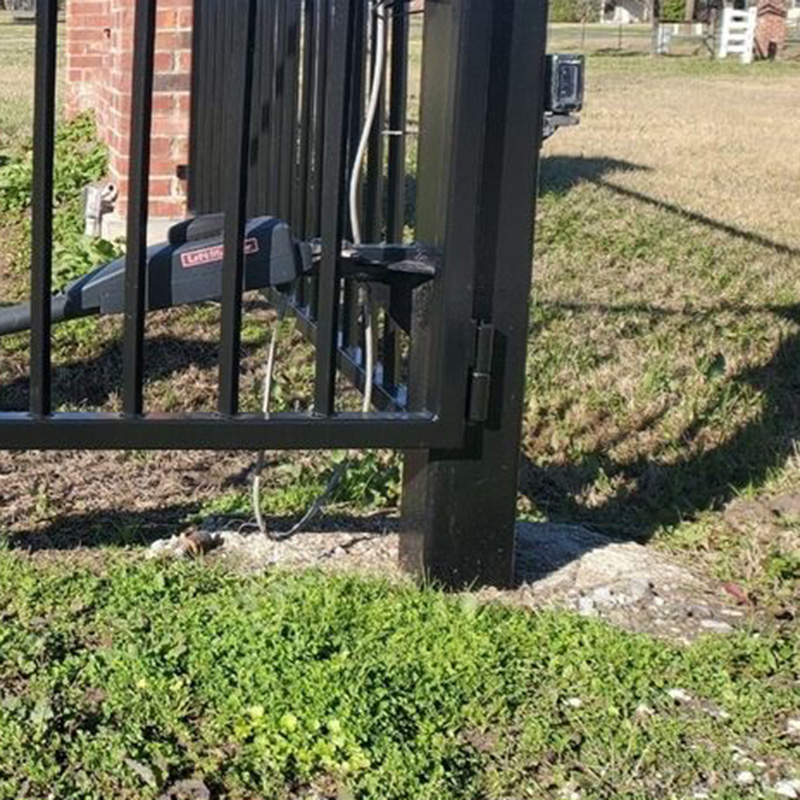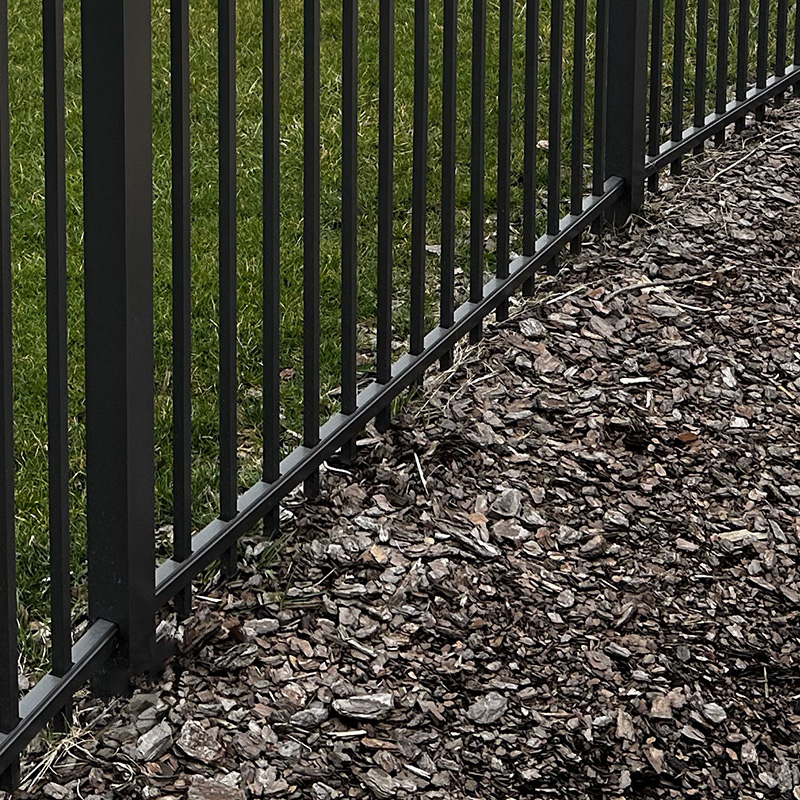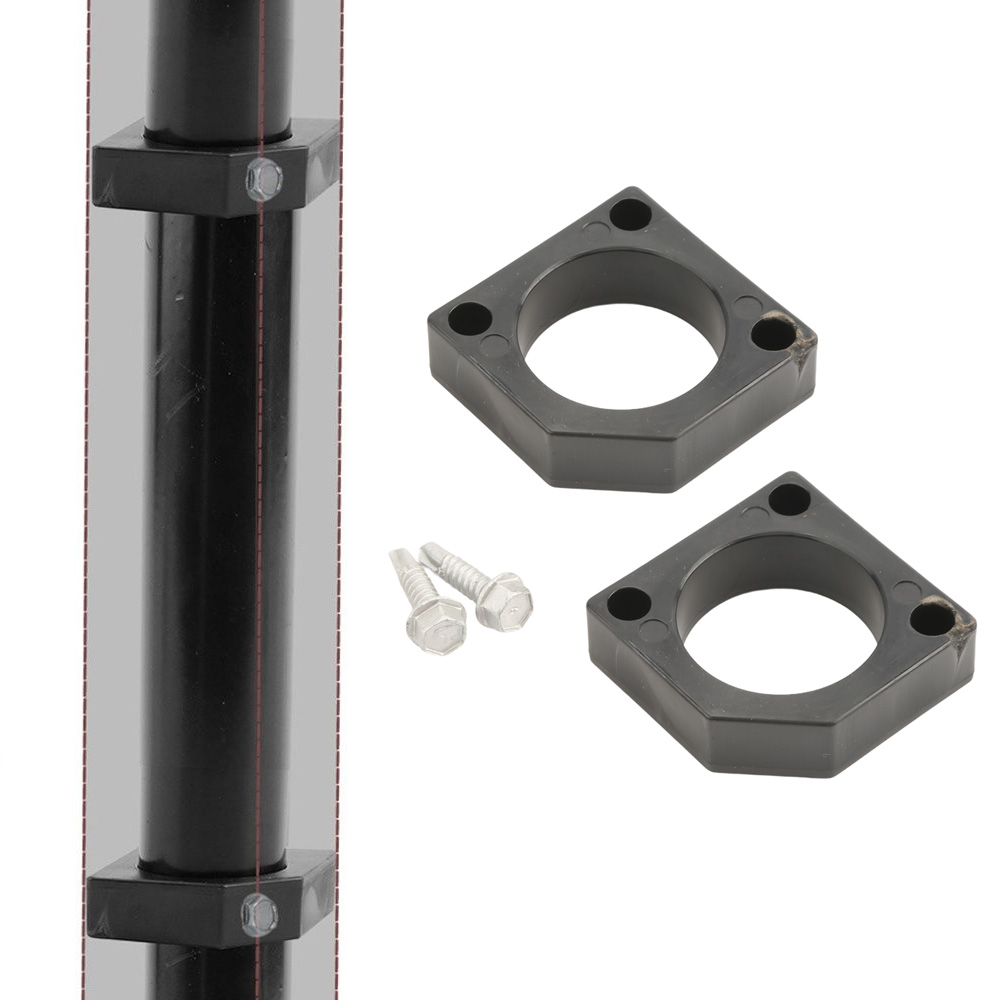Dig vs. No-Dig Aluminum Fence Posts
When it comes to installing aluminum fence posts, there are two main approaches: digging traditional post holes or using a no-dig system. Each method has its strengths, and the best choice depends on your project needs, site conditions, and how much time and effort you're looking to invest. The traditional method involves burying part of the aluminum post, typically 2 to 3 feet deep, into the ground, often set in concrete for stability. This time-tested approach works well for many applications, but it reduces the usable height of the post and typically requires more labor, tools, and cleanup.
The no-dig system, which we support, offers a streamlined alternative. Instead of inserting the aluminum post directly into the ground, this method uses a donut or post mount bracket that secures the aluminum sleeve to an internal support, typically a pipe, that is driven or set into the ground. In many cases, the inner post can be installed without digging, though concrete may still be used if desired. The key advantage is that the aluminum post itself remains above ground, preserving its full height and simplifying installation. In the sections that follow, we'll explore how each system works, when to use them, and what to consider when planning your next fencing project.
Traditional "Dig-In" Fence Post Installation
Digging and setting fence posts in concrete has long been the standard for aluminum fence installation. This method is reliable, widely used, and often recommended for permanent or high-load fencing. It works by anchoring the post securely below ground, creating a stable foundation that can withstand wind, pressure, and long-term exposure to the elements. However, it comes with trade-offs in terms of labor, materials, and the usable height of the post itself.

How It Works:
- Measure and mark your post locations.
- Use a post hole digger or auger to dig holes, typically 24 to 36 inches deep, depending on fence height and local conditions.
- Place the aluminum post directly into the hole.
- Fill the hole with concrete and level the post before the mix sets.
- Allow proper curing time before attaching panels or gates.
Benefits:
- Strong anchoring, especially for load-bearing or high-wind applications.
- Proven method accepted by most local codes and contractors.
- Ideal for uneven terrain or areas with soft soil.
Drawbacks:
- Reduces usable post height due to burial depth.
- Concrete must cure before the fence can be fully assembled.
- More challenging to adjust or relocate posts after installation.
Best Use Cases for Dig-In Posts:
- Permanent installations in areas prone to high winds or heavy impact.
- Sites with loose or unstable soil that require deep anchoring.
- Projects that must meet traditional building code requirements.
- Installations where maximum load-bearing capacity is critical.
Understanding the No-Dig Fence Post Installation Method
The no-dig method offers a modern, practical alternative to traditional fence post installation, especially when you want to avoid the hassle of digging and concrete work. With this system, the aluminum post is not buried at all. Instead, a separate internal support, such as a pipe, ground spike, or steel rod, is driven into the ground using a post driver or similar tool. The aluminum post sleeve is then placed over this internal support and secured using a donut or post mount bracket. This preserves the full height of the aluminum post, simplifies the process, and minimizes disruption to the surrounding area. It's a great option for faster installations, working over hard surfaces, or achieving a clean and consistent finished height across your fence line.

How It Works:
- Mark the desired locations for each post.
- Drive the internal support (pipe, spike, or rod) directly into the ground using a post driver, no digging required.
- Slide the aluminum post sleeve over the internal support.
- Secure the post in place using a donut collar or post mount bracket.
- Double-check that the post is level before attaching any fence panels or hardware.
Benefits:
- Preserves full aluminum post height, no need to bury any portion of the post.
- Quick and easy installation without digging or concrete.
- Ideal for use on hard-packed soil, gravel, or concrete pads.
- Reduces labor, installation time, and cleanup.
- Supports cleaner, more consistent post alignment across the fence line.
Drawbacks:
- Less ideal for extremely loose or sandy soil without added stabilization.
- Additional brackets or collars may be needed for long-term durability in some applications.
- Not always recognized by traditional contractors or building inspectors unfamiliar with the system.
Best Use Cases for No-Dig Posts:
- Residential fences where clean aesthetics and full post height are important.
- Projects on firm or compacted ground, gravel, or even over concrete pads.
- DIY installations where ease and speed are major priorities.
- Situations where minimizing digging, cleanup, and landscape disruption is preferred.
- Retrofit or upgrade projects where existing posts or foundations can be reused.
FAQs and Misconceptions

Does "no-dig" really mean no digging at all?
Yes, at least for the aluminum post itself. In a no-dig setup, the aluminum post stays above ground and is never buried. Instead, an internal support (like a pipe or spike) is driven into the ground. While ground conditions may require a bit of prep or effort to install that internal support, there's no need to dig a full post hole or pour concrete.
Is a no-dig system as secure as traditional posts set in concrete?
For most residential and light commercial applications, yes. When installed correctly using a solid internal support and a secure donut or bracket, a no-dig post can hold up just as well as a buried one. For extra-heavy gates or high-wind zones, you may want to choose a reinforced support system, but even then, digging isn't always necessary.
What tools do I need for a no-dig installation?
Just the basics: a post driver or mallet to install the internal support, a level to ensure plumb alignment, and a wrench or screwdriver for securing the bracket or donut. Compared to the digging, mixing, and curing involved in traditional installs, it's a much faster and cleaner process.
Can I install no-dig posts over concrete or pavement?
Yes. In these cases, a surface-mount bracket or anchored base plate can be used instead of a driven post. The aluminum post still fits over the support and is secured using the same no-dig method, no trenching or coring needed.
Will my local building code allow no-dig fencing?
Most residential projects don't require permits for fencing, but if you're in an area with strict building codes, it's always smart to double-check. The no-dig system is a hardware-supported method, not a gimmick, so with proper materials and installation, it often meets or exceeds local standards.
Can I switch from dig-in to no-dig on an existing project?
In many cases, yes. If your original posts are worn out or you're changing your fence layout, you can remove the old buried posts and reuse the holes for internal supports, or simply move to a nearby location and start fresh with a no-dig post and bracket. It's a flexible system that works great for upgrades and retrofits.
Dig vs. No-Dig Aluminum Fence Posts Recap
Digging and setting fence posts in concrete may be the old-school method, but it's no longer the only option. The no-dig aluminum post system offers a faster, cleaner, and more user-friendly way to build a secure fence without sacrificing strength or aesthetics. Whether you're a DIYer looking for a weekend-friendly install or a contractor aiming to save time on the job site, the no-dig approach delivers flexibility and full post height with less effort and mess.
And when it comes to hardware that makes no-dig possible, choosing the right mounting bracket is key. We recoccomend this Round-To-Square Aluminum Fence Bracket, designed specifically for no-dig installations, making it easier than ever to mount a 2-1/2" square aluminum post to a 1-5/8" round support pipe. If you're ready to simplify your next fence project, this is the upgrade you've been waiting for.
Perfect for both residential and light commercial jobs, this no-dig bracket is a great match for DIY installers and pros alike. It's compatible with our most popular post styles and installs in just seconds. Just slide one onto either end of the post and screw in.
Questions about how it works or whether it's the right fit for your project? Reach out! We are always happy to assist!
Contact Us
